RADIUM AGE: 1900
By:
April 17, 2022

A series of notes — Josh calls it a “timeline,” but Kulturfahrplan might be the more apt term — towards a comprehensive account of the science fiction genre’s Radium Age (1900–1935). These notes are very rough-and-ready, and not properly attributed in many cases. More information on Josh’s ongoing efforts here and here.
RADIUM AGE TIMELINE: [1900 | 1901 | 1902 | 1903] | 1904 | 1905 | 1906 | 1907 | 1908 | 1909 | 1910 | 1911 | 1912 | 1913 | 1914 | 1915 | 1916 | 1917 | 1918 | 1919 | 1920 | 1921 | 1922 | 1923 | 1924 | 1925 | 1926 | 1927 | 1928 | 1929 | 1930 | 1931 | 1932 | 1933 | [1934 | 1935]. (The brackets, here, indicate “interregnum” years — i.e., periods of overlap between sf’s Radium Age and its Scientific Romance and so-called Golden Age eras.)
According to my eccentric periodization scheme, the cultural era of the Nineteen-Oughts begins c. 1904. So the first few years of the Twentieth Century should be regarded as a kind of interregnum between sf’s Scientific Romance era and the Radium Age. As we look at the years 1900–1904, say, we will find elements of both eras intermingling; and all traces of the Scientific Romance era will not vanish even after 1904.
If we were to divide the Radium Age into quarters, 1900 would be the first year of its first quarter (1900-1908). How might we characterize this sub-era? Something for me to think about.
Pulp magazines (often referred to as “the pulps”) were inexpensive fiction magazines that were published from 1896 to the late 1950s. The term “pulp” derives from the cheap wood pulp paper on which the magazines were printed. In contrast, magazines printed on higher-quality paper were called “glossies” or “slicks.”
The pulps gave rise to the term pulp fiction in reference to run-of-the-mill, low-quality literature. Pulps were the successors to the penny dreadfuls, dime novels, and short-fiction magazines of the 19th century.
In 1888, Munsey changed his boys’ adventure magazine The Golden Argosy to The Argosy — and in 1896, four years before this series begins, it would become the first all-fiction pulp magazine. Note that having developed out of the tradition of dime novels and boys’ magazines, the pulps (even 1899’s Munsey’s Magazine, though aimed at adult readers) would from the start be tainted with a juvenile image.
The steam-powered printing press had been in widespread use for some time, enabling the boom in dime novels; prior to Munsey, however, no one had combined cheap printing, cheap paper and cheap authors in a package that provided affordable entertainment to young working-class people. In six years, Argosy went from a few thousand copies per month to over half a million.
Fun fact: Popular fictional characters who would arise from the pulps include Biggles, Buck Rogers, Conan the Barbarian, The Continental Op, Doc Savage, Hopalong Cassidy, John Carter of Mars, Nick Carter, Raffles, Sexton Blake, the Shadow, Tarzan, and Zorro.
A note, here at the beginning of this series, about women writing proto-sf. Later installments in the series will look at how women were increasingly pushed out of the genre during the so-called Golden Age of science fiction.
Pamela Sargent, writing in her introduction to More Women of Wonder, notes the following:
It is sometimes forgotten that during science fiction’s earlier days, the genre must have seemed very attractive to the few women who wrote it. In sf, at least, they could write adventure stories or speculate about science and technology. To some of them, science fiction probably appeared to offer them a freer rein than other types of writing. Men may have dominated the field, just as they have dominated many human endeavors because of social conditioning and circumstance.
Sargent goes on to point out that “circumstance” often included bias and discrimination on the part of sf publishers and editors. Her examples — Andre Norton was compelled to use a male/androgynous byline; Judith Merril was compelled to give her female characters traditional roles — are drawn from the Golden Age.
Proto-sf coinages dating to 1900, according to the Historical Dictionary of Science Fiction: AEROCAR (a small, personal flying vehicle, in F.C. Smale’s “Abduction of Alexandra Seine” in Harmsworth Magazine) | ANTI-GRAVITATIONAL (acting against gravity, in G. Griffith’s “Visit to Moon,” Pearson’s Magazine) | BATTLESHIP (a military spaceship having heavy armor and powerful weapons, in R. W. Cole’s Struggle for Empire) | BOAT (a spaceship, in R. W. Cole’s Struggle for Empire) | CRUISER (a spaceship, in R. W. Cole’s Struggle for Empire) | EARTHBORN (originating on Earth, as opposed to outer space or another celestial body, in G. Griffith’s “Visit to Moon”) | HOMEWORLD (the planet on which an individual being was born; the planet on which a species originated, in G. Griffith’s “Visit to Moon” | MARTIAN (the language of Martians, in Harper’s Weekly) | MIDSPACE (outer space, viewed as an area in its own right, in the Glasgow Herald) | VESSEL (used to refer to a spacecraft, in G. Griffith’s “Visit to Moon.”
- H.G Wells‘s The First Men in the Moon — serialized in The Strand 1900–1901. Bedford, a businessman, and Cavor, a scientist and inventor, discover that the Moon is inhabited by a sophisticated extraterrestrial civilization of insect-like creatures. Brian Stableford argues this is the first alien dystopia. In a six-year stretch from 1895 to 1901, Wells had produced a stream of what he called “scientific romance” novels, which included The Time Machine, The Island of Doctor Moreau, The Invisible Man, The War of the Worlds and — last in this series — The First Men in the Moon. This was a dazzling display of new thought, endlessly copied since. Adapted as a movie in 1919, 1964, and 2010. Fun fact: C.S. Lewis’s science fiction books were written as an antithesis to this novel in particular. See this site for more illustrations.
- Jack Adams’s NEQUA or The Problem of the Ages is said to be one of the first feminist science fiction books published in the United States. It was first serialized in the newspaper Equity. Two editions were published in Kansas in 1900. In the body of the work it is revealed that Jack Adams is actually a woman (Cassie) dressing in men’s clothing, who has spent several years searching for her betrothed on various ocean voyages. Sailing towards the north pole, her ship winds up inside the planet, where they meet the Altrurians, a society which has developed into a more cooperative society than those on the outside of the earth. The book’s authors are A. O. Grigsby and Mary P. Lowe, co-editors of Equity.
- Don Mark Lemon’s “Doctor Goldman” — in which a tissue transplant transfers a dead man’s memories; and the American magician who received the transplant used ventriloquism to get revenge on the killer — appears in the December issue of The Black Cat. Note that The Black Cat, a Boston-based periodical launched in October 1895, was not technically a pulp magazine. Bleiler says of Lemon that “his work is often marked by very original ideas.” His first sf story?
- Caroline Atwater Mason’s A Woman of Yesterday — see this list of Pre-1950 Utopias and Science Fiction by Women.
- Eloise O. Randall’s Reinstern — see this list of Pre-1950 Utopias and Science Fiction by Women.
- L.T. Meade’s The Sanctuary Club — see this list of Pre-1950 Utopias and Science Fiction by Women.
- Garrett P. Serviss’s The Moon Metal, a Verne-like proto-sf novella — originally published in book form, then serialized in 1905 by The All-Story Magazine; though Bleieler says it was syndicated in newspaper form in late 1900. Following the discovery of a rare metal, around 1940, by the mysterious Max Syx(maybe a supernatural being), that replaces gold as the world’s monetary standard, human greed reduces the Moon to rubble (because the metal is brought from the Moon via matter transmitter) and the Earth narrowly escapes destruction. In Moskowitz’s A History of the Scientific Romance we read that Serviss’s novel’s emotional content is handled so well that it has remained fresh and effective and has become a fixed classic in sf; Bleiler says it is Serviss’ best story. Also see Serviss’s Edison’s Conquest of Mars (1898), a response to Wells’ The War of the Worlds, which appeared the previous year. Serviss (1851–1929) was an American astronomer, popularizer of astronomy, and early sf writer.
- John Durworth’s “In an Unknown World” — a Black Cat story about the transposition of the senses, resulting from a blow to the head. Turns out the surgeon who operated on him switched his brain connections. Bleiler calls it “competent commercial work.”
- Newton Newkirk’s (Clyde C. Newkirk, a Massachusetts-based journalist) “A Human Chameleon” — another Black Cat story — a kind of superman, whose head and hands can become invisible thanks to “chameleon fever.”
- Shunrō Oshikawa‘s Submarine Warship (or Submarine Battleship) — which imitates elements of Jules Verne’s Twenty Thousand Leagues Under the Sea (1870; translated 1884 in Japan). A patriotic scientist drags Japan into the modern world by carving out a sphere of influence in far-flung colonies. More info on the author. More info on the story. More info.
- Fred Smale’s “The Abduction of Alexandra Seine” — a satirical British story, which appeared in the November 1900 issue of The Harmsworth Magazine. In the early 1950s, Alexandra Seine is kidnapped by a notorious aerocar racer. Various futuristic devices, including a telepathic communication device. Bleieler says: “An anticipation of Gernsback’s Ralph 124C41+ with a note of parody.”
- Jingo Jones (pseud.)’s The Sack of London by the Highland Host. Satirical novel of revolt of Scots clans in response to publication of a unflattering cartoon in PUNCH.
- Bradford C. Peck’s The World a Department Store: A Story of Life Under a Coöperative System is a utopian novel whose protagonisyt wakes up in the future to learn that the co-operative movement has transformed the Lewiston, Maine, he knew into Coöperative City, which is run on a vastly different and improved system. A native of Lewiston himself, Peck built the largest department store in the state in its time. In reaction to the chaotic business conditions of the Panic of 1893, he began to develop a commitment to the emerging cooperative movement.
- F.M. Allen [pseud. of Edmund Downey]’s London’s Peril. A plan by the French to invade through a Channel Tunnel. See more.
- George Griffith’s A Honeymoon in Space. Episodic rubbernecking around the solar system; interplanetary sections were published individually in Pearson’s Magazine. Bleiler calls it “infantile.” See this blog post for more info on Griffith, author of The Angel of the Revolution (1893), Olga Romanoff or the Syren of the Skies (1894), The Outlaws of the Air (1895), “A Photograph of the Invisib;e” (1896), The Romance of Golden Star (1897), “A Corner in Lightning” (1898, Bleiler says it may be his best story), “The Conversion of the Professor, A Tale of the Fourth Dimension” (1899), The Great Pirate Syndicate (1899). Bleiler calls Griffith one of the important figures in turn-of-the-century British proto-sf, though he notes he is “a prolific but inferior hack.”
- Karl Eisenhart’s Die Abrechnung mit England — Germany attacks England.
- Robert Cole’s first and best novel, The Struggle for Empire: A Story of the Year 2236 (1900) takes the future war story — popular during sf’s scientific romance era — to its logical, grim conclusion. The Anglo-Saxon Federation – ostensibly a utopia but in truth a dystopia where the rich have plundered the planet – expands ominously into other solar systems in search of raw material to exploit. Interstellar warfare breaks out between Earth and a superior race from the Sirius system. The descriptions of space battles, and of an Earth surrounded by a barrage of space torpedoes and mines while scientists struggle to perfect the ultimate weapon, make it – as Bleiler argues – the precursor to and equal of many of the space-opera stories of the 1930s. It is often credited with being the first novel to introduce the concept of galactic empires, interstellar travel with spacecraft traveling at many millions of miles per hour and fleets of starships in the thousands locked in combat. (All of this in stark contrast to most otherworldly future war stories of the time, which tended — per the Edgar Rice Burroughs school of interplanetary pulp — to be mostly fought with swords.
- Colonel F.N. Maude’s The New Battle of Dorking. France invades England.
- Simon Newcomb’s His Wisdom, The Defender. World peace maintained by fleets of super-science, dirigible-type craft. Newcomb was a Canadian–American astronomer, applied mathematician, and autodidactic polymath who made important contributions to timekeeping, as well as to other fields in applied mathematics, such as economics and statistics; and he was first president of the American Society for Psychical Research. (He studied under Benjamin Peirce, and is said to have contributed to the destruction of C.S. Peirce’s career.) In his popular writings, Newcomb helped popularize connections between the mathematical and spiritualist notions of a fourth dimension.
- George Griffith’s “A Visit to the Moon”
- George Griffith’s “The World of the War God” — Rollo Lenox Smeaton Aubrey, Earl of Redgrave, and his bride, Lilla Zaidie, leave the earth on a visit to the moon and the principal planets; their sole companion being Andrew Murgatroyd, an old engineer who had superintended the building of the Astronef in which the journey is made. By means of the “R Force,” or Anti-Gravitational Force, of the secret of which Lord Redgrave is the sole possessor, they are able to navigate with precision and safety the limitless ocean of space.
- George Griffith’s “A Glimpse of the Sinless Star”
- George Griffith’s “The World of the Crystal Cities”
- George Griffith’s “In Saturn’s Realm”
- George Griffith’s “Homeward Bound”
- George Griffith’s “A Visit to the Moon”
- W.M. Stannard’s “Mr. Corndropper’s Hired Man” (in The Black Cat) features a mechanical-man slave.
- C.J. Cutcliffe Hyne’s The Lost Continent. Hyne’s most famous fantastic novel. Set in Atlantis at the time of its destruction, caused by a retributive flood (the sinfulness that arouses the elements is tinged with female sexuality, in the form of an amoral she-figure known as Queen Phorenice). The presence of inimical plesiosaurs makes plausible the suggestion that Arthur Conan Doyle may have known the story when he wrote The Lost World (1912). This is the best of several novels published in the wake of Ignatius Donnelly’s ATLANTIS: THE ANTEDILUVIAN WORLD (1882), which popularized the mythology of the sunken continent for Victorian readers. With tongue slightly in cheek, Hyne treated the myth as it really deserved to be treated: as a grandiose exercise in imaginative sensationalism.” – Stableford, Scientific Romance in Britain 1890-1950
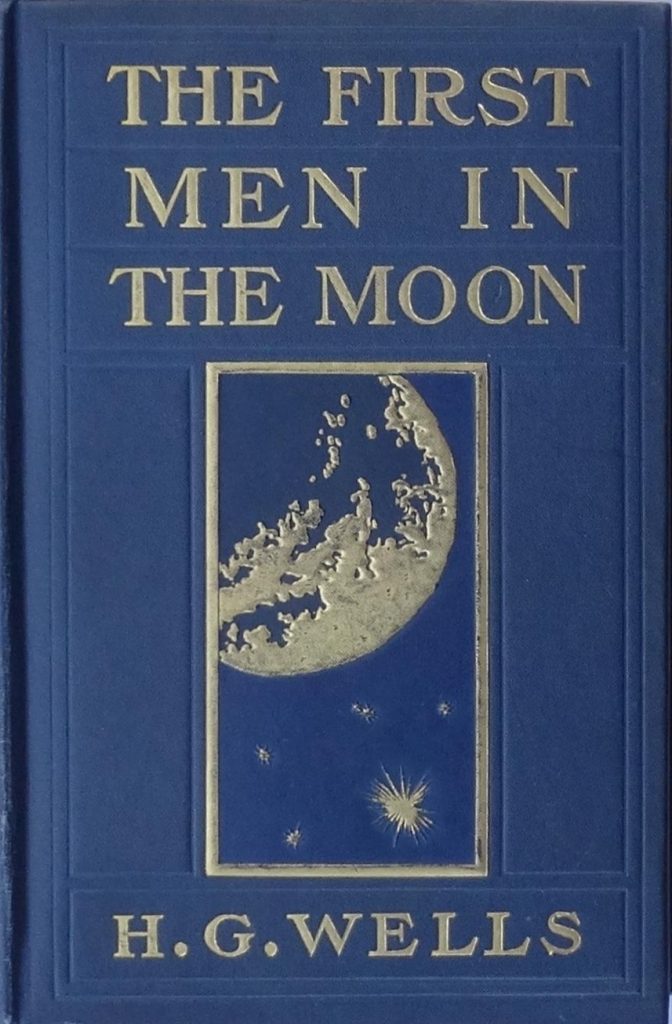
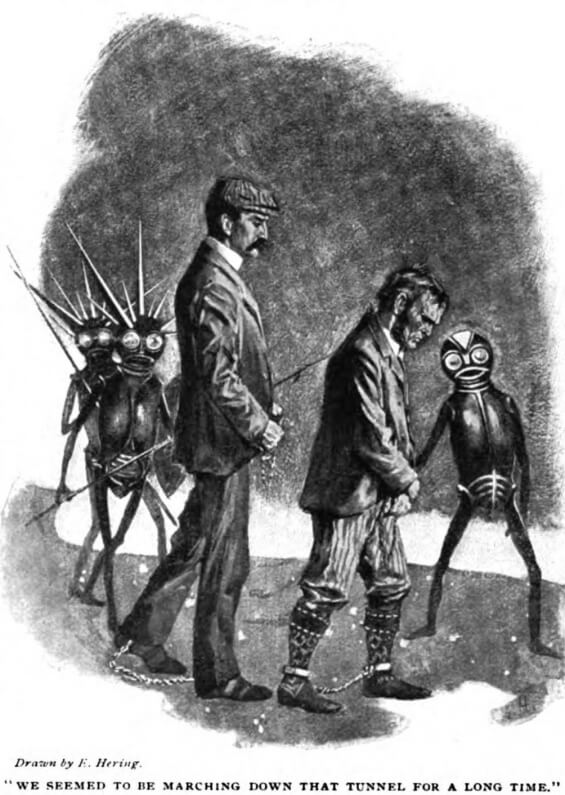
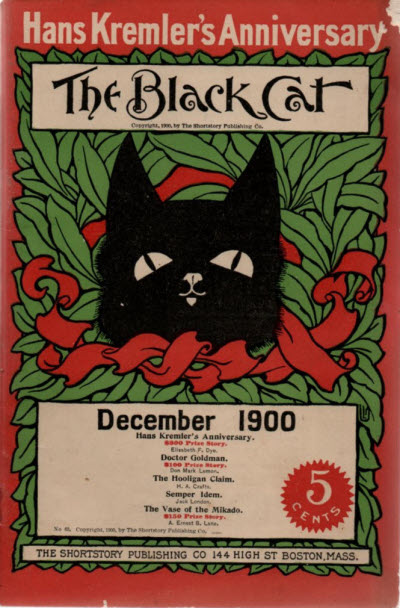
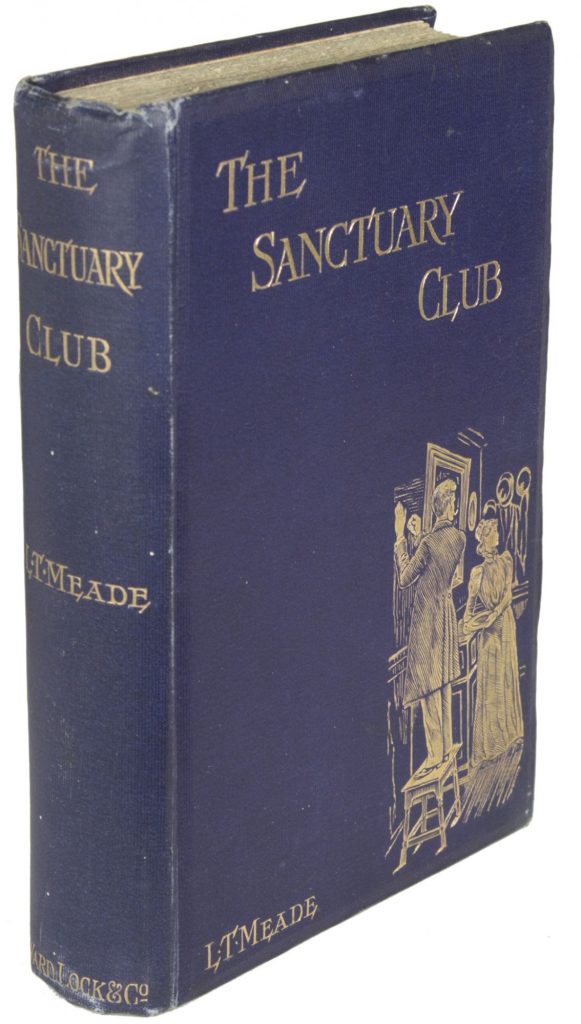
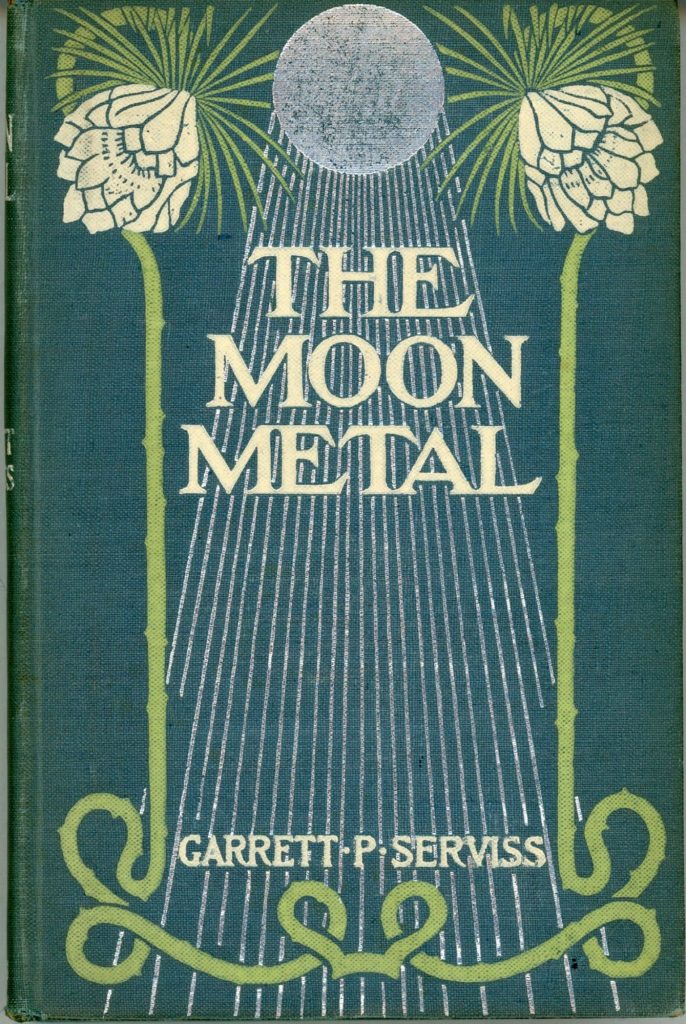
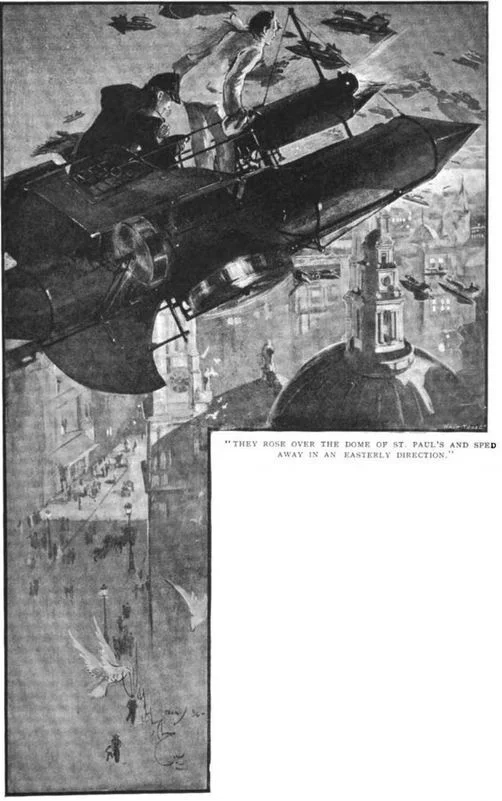
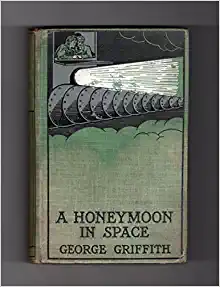
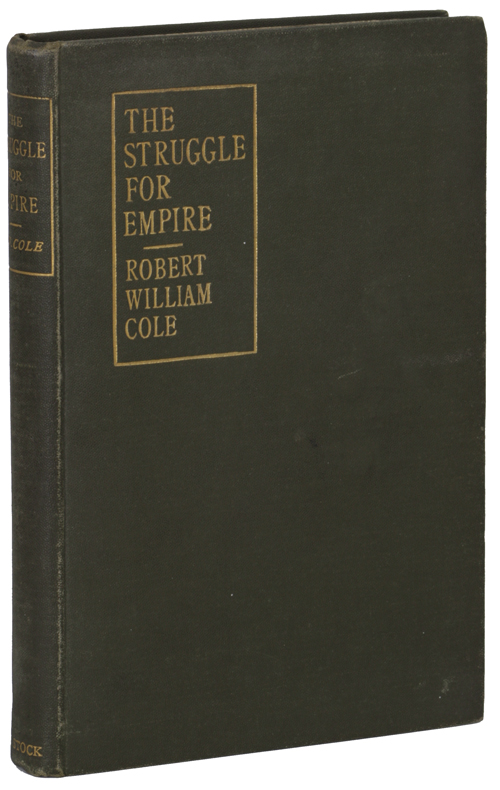
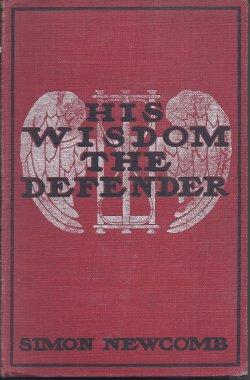
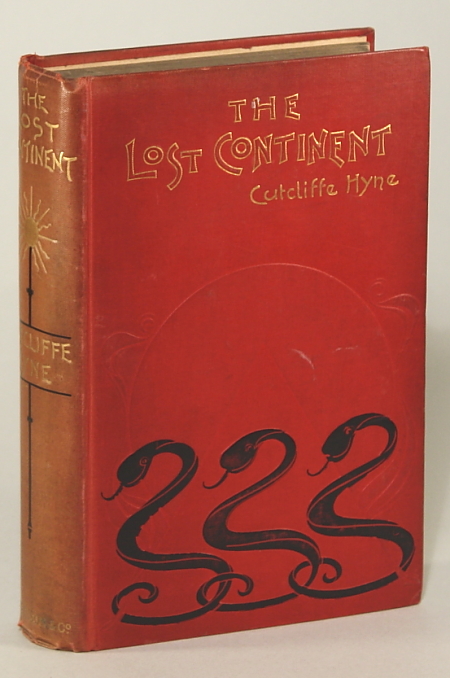
ALSO: Planck formulates quantum theory; Villard identifies a third kind of radiation — gamma rays (Rutherford identified alpha and beta rays in 1899; Marie Curie, who’d recently coined the term “radioactivity,” becomes the first woman faculty member at the École Normale Supérieure). The Boer War raging. King Umberto I of Italy murdered by anarchists. Freud’s The Interpretation of Dreams (his first important major writing; Freud depicts the Unconscious as a cunning trickster that plays games with the conscious mind, disclosing yet not disclosing — via a symbolically ingenious language — what it can bear neither to leave alone nor to reveal), Simmel’s The Philosophy of Money (a Nietzschean vision of modernity as a fluctuating process that rigidifies into economic, cultural, and social forms that are then burst apart by new socioeconomic forces). The era of the Dublin School — Yeats, Moore, Joyce, Synge, Stephens; an insurrection against UK prose by way of Mallarmé and the Symbolists — begins.
Beginning with an obscure discovery in 1896, radioactivity led researchers on a quest for understanding that ultimately confronted the intersection of knowledge and mystery.
From 1900 Marie Curie had a part-time teaching post at the École Normale Supérieur de Sèvres for girls. After thousands of crystallizations, Curie finally — from several tons of the original material — isolated one decigram of almost pure radium chloride and had determined radium’s atomic weight as 225.
Mysterious from the start, radioactivity attracted researchers who asked: What causes certain atoms to give off invisible, penetrating rays? Where did the energy come from? These questions became increasingly pressing when researchers realized the process seemed to continue indefinitely, producing huge quantities of energy. Investigators found cases where radioactivity did change, forcing them to the startling conclusion that radioactive bodies were transmuting into other substances. Chemical elements were not immutable after all. Radioactivity produced traces of matter so minuscule and evanescent that researchers had to devise new techniques and instruments to investigate them.
Scientists in Paris, Manchester, and Vienna (primarily, but all over the world) unraveled the details of radioactive transformations. They created a new science with specialized techniques, instruments, journals, and international conferences. Women entered the field in unprecedented numbers. Experiments led to revolutionary ideas about the atom and speculations about atomic energy. The excitement spilled over to the public, who expected miracles from radium, a scarce element discovered solely by its radioactivity.
Entrepreneurs created new industries, and physicians devised novel treatments for cancer. Radioactivity gave archaeologists methods for dating artifacts and meteorologists a new explanation for the air’s conductivity. Their explorations revealed a mysterious radiation from space. Radioactivity profoundly changed science, politics, and culture. The field produced numerous Nobel Prize winners, yet radioactivity’s talented researchers could not solve the mysteries underlying the new phenomenon. That was left to a new generation and a new way of thinking about reality.
Poincaré’s support for Lorentz’s “wonderful invention” of local time (and remark that it arises when moving clocks are synchronized by exchanging light signals assumed to travel with the same speed in both directions in a moving frame) is a contribution to special relativity; Poincaré discusses the “principle of relative motion” in two papers in 1900.
The Boxer Rebellion (1899 – 1901) was led by the Society of the Righteous and Harmonious Fists (called the Boxers in the West), who sought to save China by killing Western colonialists in China. In fact, most of the victims of the Boxer Rebellion were Chinese Christians — but Western journalists and politicians cynically used the rebellion to add fuel to the 19th-century “Yellow Peril” fear that the peoples of East and Southeast Asia posed an existential danger to the West. (The phrase “Yellow Peril” was coined by the Russian sociologist Jacques Novikow and popularized by Kaiser Wilhelm II.) Radium Age proto-sf stories on this racist theme would include: Pierre Giffard’s La Guerre infernale (1908), Jack London’s “The Unparalleled Invasion” (1910), Sax Rohmer’s The Mystery of Dr. Fu-Manchu (serialized 1912) and sequels, H. Irving Hancock’s “Under the Ban of Li Shoon” (1916), J. Allan Dunn’s The Peril of the Pacific (1916), and H. P. Lovecraft’s “He” (1926).
Bergson’s Laughter: an Essay on the Meaning of the Comic suggests that a rigidity of form and movement works towards the comic, in part because this “inelasticity” shows a human as an automata. Stiff, mechanical movement shows “a certain fundamental absentmindedness. “We laugh every time a person gives us the impression of being a thing.” Bergson worried about “mechanization” — the restriction of freedom, creativity and life, and their reduction to the status of the mechanical or non-living.
Husserl’s Logische Untersuchungen (The Logical Investigations, 1900–1901) are a two-volume work in which the author discusses the philosophy of logic and criticizes psychologism, the view that logic is based on psychology. It’s an attempt to extend an analysis of the structure of meaningful expressions into an account of the structure of meaning in experience. The Logical Investigations influenced philosophers such as Heidegger and Lask, and contributed to the development of phenomenology, continental philosophy, and structuralism. (The book influenced Talcott Parsons’ The Structure of Social Action (1937), and the Prague linguistic circle, thereby helping to establish the form of structuralism represented by Claude Lévi-Strauss. The work influenced Roman Jakobson, who also left an important mark on semiotics and structuralism.
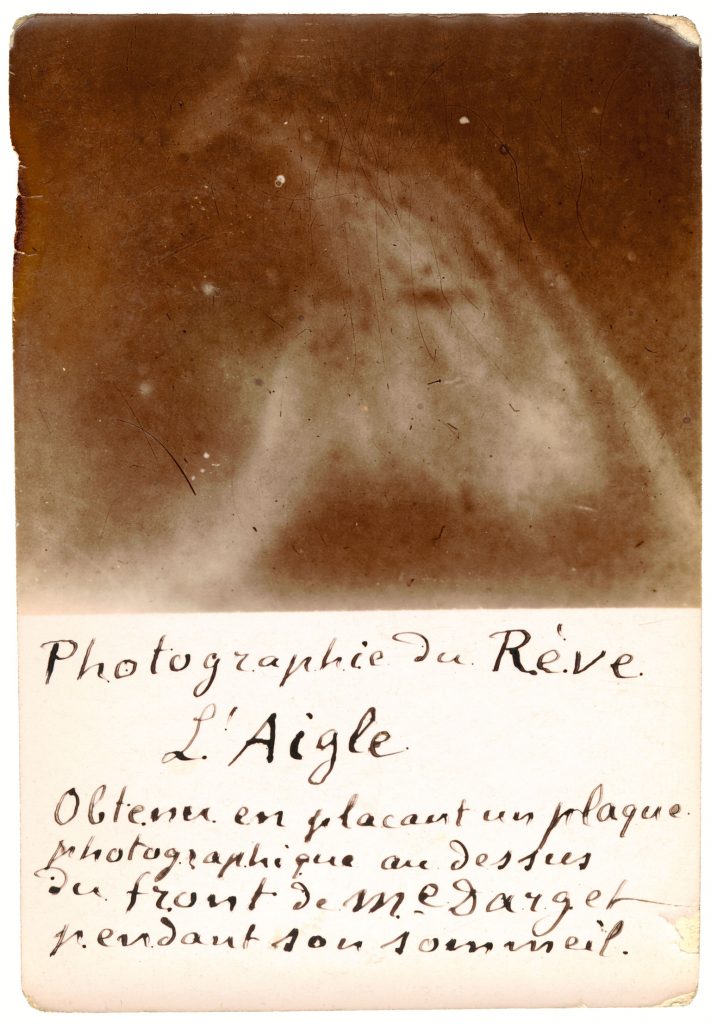
Röntgen’s isolation of X-rays in 1895, and his discovery that they could be recorded on film, spurred investigation into the ways that other non-visible wavelengths could be captured. It tantalized late 19th-century and early 20th-century fascination with spiritualism and the occult, offering the possibility that other dimensions might be revealed. The founding fathers of thought photography are the Frenchmen Darget (1847–1921) and Baraduc (1850–1909); Darget was an amateur, Baraduc a respected neurologist. From the 1890s to the 1920s, numerous attempts were made to record non-visible human emanations through ‘Electrography’, Darget’s ‘Fluidal Photography’ and various other techniques, and the degree of interest was manifested in the creation of groups such as The Society for the Study of Supernormal Pictures (vice president Arthur Conan Doyle). Cf. Schenkel (ed.)’s Magical Objects: Things and Beyond (2007), and Enns and Trower (eds.)’s Vibratory Modernism (2013).
By 1900 the “eclipse of Darwinism” (to use Julian Huxley’s phrase) was setting in. Evolution was widely accepted yet natural selection seemed a tad too fantastical. Reinforcing various objections was the fact that Darwin got some things wrong. He believed that the traits of progeny were blended averages of their parents’ traits yet Mendel seemed to show that traits were passed down as discrete units.
Rediscovery of Mendel’s laws of inheritance ignites a debate between Bateson (who coined the term genetics) and other Mendelians and the biometricians (these models would be reconciled by Haldane and others). Modern genetics began with the work of the Augustinian friar Mendel; his work on pea plants, published in 1866, established the theory of Mendelian inheritance. The year 1900 marked the “rediscovery of Mendel” by Hugo de Vries, Carl Correns and Erich von Tschermak, and by 1915 the basic principles of Mendelian genetics had been studied in a wide variety of organisms — most notably the fruit fly. Led by Thomas Hunt Morgan and his fellow “drosophilists,” geneticists developed the Mendelian model, which was widely accepted by 1925. Alongside experimental work, mathematicians developed the statistical framework of population genetics, bringing genetic explanations into the study of evolution. Note that although Darwin’s theory of natural selection (Origin of Species, 1859) had presented a highly probably picture of patterns of change, it didn’t say how species change. This technical gap wasn’t closed until the development of the science of genetics in the 20th century. See 1910 for more info on the emerging science of genetics.
Note that in 1899, Sutton E. Griggs published Imperium in Imperio — in which the means to transform society are expressed through the philosophy of a secret Black government in the USA. The Imperium in Imperio is an underground compact government that functions like a nation. Griggs (1872 – 1933) was an African American author, Baptist minister, and social activist. The novel is concerned with how societal prejudices determine individual fate, and with the issue of what “progress” means for the African American community. Kalenda Eaton’s introduction to a 2022 edition suggests that the novel’s storyline engages “post-emancipation promise, white resentment and southern backlash, ‘colorism’ or intraracial discrimination within African American communities, miscegenation, political conservatism, domestic terrorism and anti-Black racist violence, regional bias, Black migration, separatism, science and romance…” The fight for citizenship rights and proper recognition within the United States is contrasted with the desire to form self-governed communities that would be protected and safe; neither of these conflicting agendas is ruled out. At what point should a patriotic American decide to stop attempting to work within the American system? If neither complacency nor race war, nor a back-to-Africa solution are desirable, then why not a Black nation within a nation?
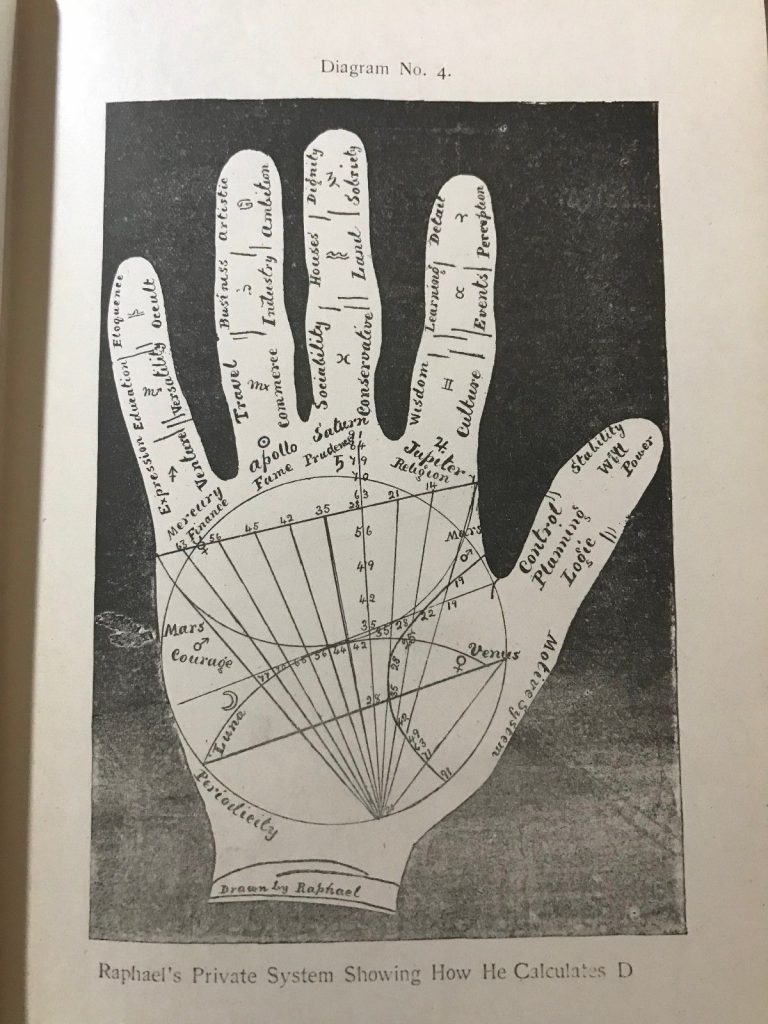
One of the goals of this series is to trace the influence of occult and mystical thought and practice of the era on the emerging sf genre. So a definition: “Mysticism” refers to the search for a state of oneness with ultimate reality. “Occultism” depends upon secret, concealed phenomena — not readily available to ordinary understanding or scientific reason — that are accessible only to those who have been appropriately initiated. Mystical-occult beliefs, transmitted through books and pamphlets featuring diagrams and illustrations that would influence the emergence of abstract art, include such ideas as: the universe is a single, living substance; mind and matter are one; all things evolve in dialectical opposition (light-dark, positive-negative, male-female, etc.), things “above” are analogous to things “below,” etc.
This idea can be traced to Charles F. Dupuis, minister of education during France’s First Republic, and a scholar of comparative religion whose multivolume Origine de tous les cultes ou religion universelle was published in 1794. He emphasized Egypt as a fountainhead of religious knowledge, and asserted that all ancient sacred mythologies embodied heaven-and-earth, sun-and-moon, male-and-female dualities. He didn’t accept their occult reality, but acknowledged these basic components of mystical iconography. Later occultists and mystics — particularly Blavatsky and the Theosophists — would get a lot of use out of this notion. Another important text was the 1818 book Symbolical Language of Ancient Art and Mythology by Richard Payne Knight, from which Blavatsky and the Theosophists got their fascination with certain geometric forms — the tau cross, the triangle, etc. 19th century occult texts were replete with diagrams made up of easily readable geometric shapes — this was the true beginning of the infographic revolution. (Look at any book about the history of data visualization, and you will find so much occult stuff. I’m thinking of, say, Manuel Lima’s The Book of Circles.) Blavatsky’s The Secret Doctrine (1888) spends page after page unpacking the esoteric meanings of the cross and the circle’ squares and triangles she unpacks in other writings. Indeed, Blavatsky was a major synthesizer of geometric symbol systems.
Why did mystical-occult thought and practice grow so popular during the 19th century? One compelling theory is that the industrial revolution and its effects on not only the economy but society and culture, coupled with the findings of Darwin and other scientists (including the first law of thermodynamics), led to the perception of life as barren and devoid of meaning. Positivist and materialist philosophies could not explain existence or provide a comforting faith in life after death; but theosophists, magicians, and mystics of the 19th century could and did. See Jennifer Wallters’ thesis “Magical Revival.”
There is a certain anti-positivism running through proto-sf. For example: Arthur Conan Doyle.
Also in 1900: Having been ejected from the Theosophical society for his magical experiments, William Butler Yeats joined the Hermetic Order of the Golden Dawn. (At various times, the order included writers Arthur Machen and Bram Stoker, the Irish revolutionary Maud Gonne, and the magicians Arthur Edward Waite and Aleister Crowley.) When Crowley showed a tendency to use his occult powers for personal gain rather than for good, the adepts of the order, Yeats among them, decided not to allow him to be initiated into the inner circle. This led to a Yeats-Crowley wizard battle in 1900, aka the Battle of Blythe Road.
In some of the spiritual movements with which this series will be concerned, there was an important crossover between metaphysical ideas and new advances in science (particularly physics and chemistry; n-dimensional geometry, the properties of time and space). Scientific advances allowed metaphysical thinkers to speculate about invisible aspects of the material universe… and to confirm their own beliefs.
Popularized beliefs about n-dimensional geometry (more than three dimensions) were essential for the Russian Futurist movement and the art of Malevich. Ouspensky would unite properties of time and space in the concept of a fourth dimension.
French mathematician Maurice Princet was known as “le mathématicien du cubisme” (“the mathematician of cubism”). An associate of the School of Paris—a group of avant-gardists including Pablo Picasso, Guillaume Apollinaire, Max Jacob, Jean Metzinger, and Marcel Duchamp—Princet is credited with introducing the work of Henri Poincaré and the concept of the “fourth dimension” to the cubists at the Bateau-Lavoir during the first decade of the 20th century.
The eighteenth and nineteenth centuries also bequeathed to the 1900–1935 era a fascination with energy flows and vibrations pervading the material world. Baudelaire, for example, had noted that “the more vigilant senses perceive more reverberating sensations.” Many mystical-occult writers were also fascinated with synaesthesia, and with sacred geometry — publishing intricate charts and diagrams — a tradition at least as old as Kircher’s 1678 chart Magnetismus Globorum Astralium or Böhme’s 1764 chart The True Principles of All Things. (Schlegel: “A philosophical work must have a definite geometrical form.”) Because the complexities and abstract truths expressed by geometrical form could only be explained as reflections of the innermost truths of the world’s being, they were held to be sacred mysteries. Art not only as a vehicle of aesthetic satisfaction but also as a conduit between the microcosm of earthly existence and the macrocosm of everlasting spiritual existence.
The positivistic intuition — that science concerns the logical extraction of laws and predictive consequences from verifiable sense data; that science makes no metaphysical leaps, but is instead a way of putting ourselves in a situation where hypotheses can be confirmed or rejected on the basis of procedures that keep one firmly anchored to physical facts and the unbiased analysis thereof — was wearing thin, at this point. As the philosopher E A. Burtt would put it, in The Metaphysical Foundations of Modern Physical Science (1924/1925), a critique of logical positivism that would influence the historian and philosopher of science Alexandre Koyré, and through Koyré the philosopher of science Thomas Kuhn, there is “no escape from metaphysics.” That is, science must account for subjective perspectives, since all objective conclusions are ultimately founded upon the subjective conditioning/worldview of its researchers and participants.
We have never been modern, as Bruno Latour puts it. Although we’ve been led to believe that the defining feature of modernity is that people no longer believe in spirits, myths, or magic, even the human sciences have been more enchanted than is commonly supposed. Philosophy, anthropology, sociology, psychoanalysis, religious studies, folklore and other disciplines contributed to the myth of disenchantment — the myth of mythless modernity — but many of these disciplines’ founding figures were not only aware of, but profoundly enmeshed in, the occult and spiritualist revivals taking place in Britain, France, and Germany; according to Jason Ananda Josephson Storm’s The Myth of Disenchantment: Magic, Modernity, and the Birth of the Human Sciences, for example, it was specifically in response to this burgeoning culture of spirits and magic that they produced notions of a disenchanted world.
T.J. Jackson Lears’s No Place of Grace: Antimodernism and the Transformation of American Culture, 1880–1920 helps contextualize (though he never mentions sf) the emergence of sf. Modernism was regarded by many brilliant thinkers and artists of the era — including William James — as something to be fought because it was synonymous with the loss of inner spiritual values. James emphasized that the only way to attain higher consciousness was to free oneself from the confines of selfhood. He was interested in how sensory, symbolic elements played an enormous part in mysticism.
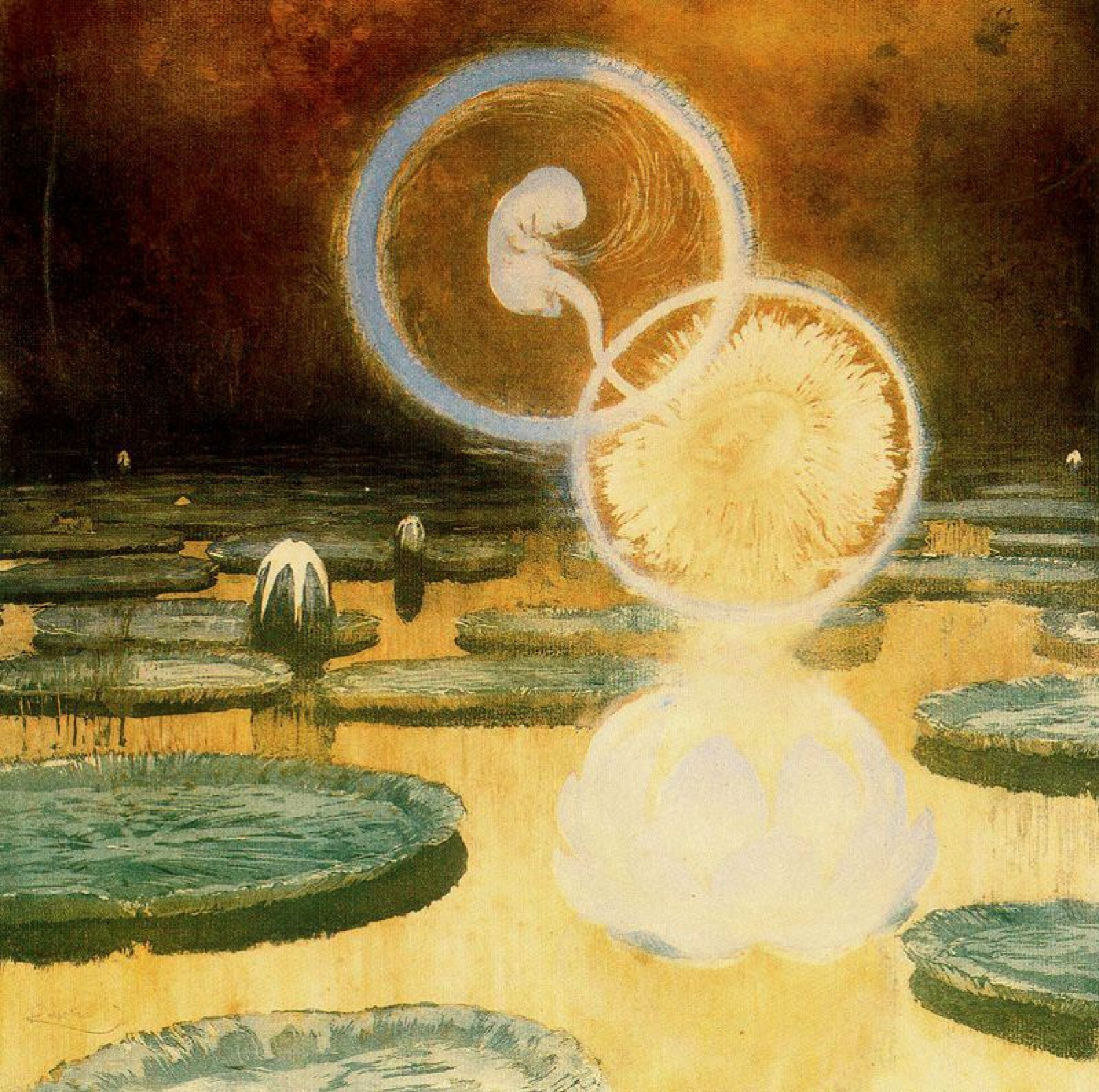
The underlying precepts of occult thought and the geometrizing signs and diagrams with which they were often illustrated in esoteric texts gradually became widely known in late 19th-century artistic circles. By the early 20th century occultism was of fundamental importance to a number of artists who practiced some form of what is called abstract art. Their involvement with the sacred geometries of occult tradition were means by which the spiritual content could be retained in their art. The trend was away from a residual naturalism toward ever more reductive forms of abstraction; for Kupka, Mondrian, Malevich, Kandinsky and others the purification of natural into abstract forms implied the proposition that geometric configurations function as paradigms of spiritual enlightenment.
Symbolism an important precursor to abstract art. It was a late 19th-century art movement seeking to represent absolute truths symbolically through language and metaphorical images, mainly as a reaction against naturalism and realism. Symbolism was a reaction against naturalism in favor of spirituality, the imagination, dreams. Odilon Redon, for example.
The Symbolist movement in Russia — which gave us Valery Bryusov, author of some Russian proto-sf stories and poetry — was deeply immersed in mystical systems of belief. Hilton Kramer suggests that Symbolism thus “disposed Kandinsky to look beyond the boundaries of naturalism and materialism” for the foundations of his pioneering asbtract art.
Jean Moréas’s Symbolist Manifesto (“Le Symbolisme”) of 1886 reads to me like Saussure or Barthes’ Mythologies — it derides “plain meanings, declamations, false sentimentality and matter-of-fact description” as a ruse of the dominant discourse. “Ainsi, dans cet art, les tableaux de la nature, les actions des humains, tous les phénomènes concrets ne sauraient se manifester eux-mêmes; ce sont là des apparences sensibles destinées à représenter leurs affinités ésotériques avec des Idées primordiales.” (Thus, in this art movement, representations of nature, human activities and all real life events don’t stand on their own; they are rather veiled reflections of the senses pointing to archetypal meanings through their esoteric connections.) This is exactly what semioticians will say about representations of nature, human activities, and all real life events — everything is a sign of a concealed meaning. The goal of the semiotician, like that of the Symbolist poet, is to “clothe the Ideal in a perceptible form” whose “goal was not in itself, but whose sole purpose was to express the Ideal” (I’m quoting the manifesto).
In a nutshell, as Mallarmé writes in a letter to his friend Henri Cazalis, the goal of Symbolist poetry and other art forms is “to depict not the thing but the effect it produces.” Semioticians do this in an empirical, painstaking manner. Symbolist poems were attempts to evoke, rather than primarily to describe.
During the time of Russia’s spiritual regeneration between the late 1890s and circa 1910, the Symbolist poets and philosophers formulated a vast conglomerate of ideas and ideologies. They explored several areas of intellectual and metaphysical inquiry. Bely, Blok, Ivanov, and Valery Bryusov, for example, were convinced that the phenomenal world covered and concealed the real world (the “substance” or the “essential”). The path of true illumination lay via intuition and cognition, not via objective knowledge.
Michael H. Whitworth (author of Einstein’s Wake) suggests that the fragmentary nature of modernist poetic form — Pound, Eliot, et al. — “seems to stand in some sort of connection to the science of the late nineteenth and early twentieth centuries.” How so? Because the themes of modern physics were those of “disintegration, violence, and derangement.” (He is quoting historian of science Gerald Holton’s Thematic Origins of Scientific Thought (1973).
Alan J Friedman and Carol C. Donley’s Einstein as Myth and Muse: “Twentieth-century physics postulated and experimentally validated two new world views, relativity theory and quantum theory, which differed from the conventional so fundamentally that philosophers and artists were encouraged to assimilate similar revolutionary views into their own disciplines. Modern painting, for example, developed a new spatial ordering. The new world views opened a huge realm of unexplored possibilities and demanded a change in our imaginative picture of the world.
Artists in all fields welcomed this opportunity, studied the new ideas, and experimented with art forms consonant with their time. Wyndham Lewis points out that the experiments involved ‘not only technical and novel combinations, but also the essentially new and particular mind that must underlie, and should even precede, the new and particular form, to make it viable.'”
Also:
“Many artists contemporary with physicists Albert Einstein, Werner Heisenberg, and Niels Bohr found that conventional forms were inadequate in the context of the new physical understandings. New forms had to be created in order to give shape to the new ideas, and the new forms in one discipline often paralleled those in others. Thus as four-dimensional geometries appeared in mathematics and physics, treating time as a dimension equivalent to those of space, the traditional three-dimensional representation in art expanded to include temporal dimension in avant-garde painting. The arts became concerned with time as a dimension and with space-time relationships. Physicists found there was no universal frame of reference, and multiple viewpoints showed up on paintings and in novels. Physicists indicated that the flux of a field represented the strength of its source, and artists began inventing their own “field” forms. Relationships between objects became more important than the objects themselves. When physicists discovered they could not simultaneously find a particle’s exact position and exact momentum, they admitted the basic indeterminism inherent in the quantum theory, which gives a probabilistic rather than a causal description of nature: In literature conventional consecutive plots often disappeared and standard syntactical relationships were fractured.”
MORE RADIUM AGE SCI FI ON HILOBROW: HiLoBooks homepage! | What is Radium Age science fiction? |Radium Age 100: 100 Best Science Fiction Novels from 1904–33 | Radium Age Supermen | Radium Age Robots | Radium Age Apocalypses | Radium Age Telepaths | Radium Age Eco-Catastrophes | Radium Age Cover Art (1) | SF’s Best Year Ever: 1912 | Radium Age Science Fiction Poetry | Enter Highbrowism | Bathybius! Primordial ooze in Radium Age sf | War and Peace Games (H.G. Wells’s training manuals for supermen) | Radium Age: Context series | J.D. Beresford | Algernon Blackwood | Edgar Rice Burroughs | Karel Čapek | Buster Crabbe | August Derleth | Arthur Conan Doyle | Hugo Gernsback | Charlotte Perkins Gilman | Cicely Hamilton | Hermann Hesse | William Hope Hodgson | Aldous Huxley | Inez Haynes Irwin | Alfred Jarry | Jack Kirby (Radium Age sf’s influence on) | Murray Leinster | Gustave Le Rouge | Gaston Leroux | David Lindsay | Jack London | H.P. Lovecraft | A. Merritt | Maureen O’Sullivan | Sax Rohmer | Paul Scheerbart | Upton Sinclair | Clark Ashton Smith | E.E. “Doc” Smith | Olaf Stapledon | John Taine | H.G. Wells | Jack Williamson | Stanisław Ignacy Witkiewicz | S. Fowler Wright | Philip Gordon Wylie | Yevgeny Zamyatin
